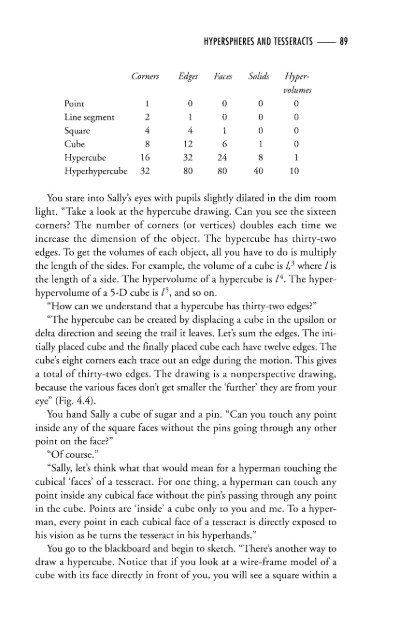clifford_a-_pickover_surfing_through_hyperspacebookfi-org
clifford_a-_pickover_surfing_through_hyperspacebookfi-org
clifford_a-_pickover_surfing_through_hyperspacebookfi-org
You also want an ePaper? Increase the reach of your titles
YUMPU automatically turns print PDFs into web optimized ePapers that Google loves.
HYPERSPHERES AND TESSERACTS<br />
89<br />
Point<br />
Line segment<br />
Square<br />
Cube<br />
Hypercube<br />
Hyperhypercube<br />
Corners Edges Faces Solids Hyper-<br />
1<br />
2<br />
4<br />
8<br />
16<br />
32<br />
0<br />
1<br />
4<br />
12<br />
32<br />
80<br />
0<br />
0<br />
1<br />
6<br />
24<br />
80<br />
0<br />
0<br />
0<br />
1<br />
8<br />
40<br />
volumes<br />
0<br />
0<br />
0<br />
0<br />
1<br />
10<br />
You stare into Sally's eyes with pupils slightly dilated in the dim room<br />
light. "Take a look at the hypercube drawing. Can you see the sixteen<br />
corners? The number of corners (or vertices) doubles each time we<br />
increase the dimension of the object. The hypercube has thirty-two<br />
edges. To get the volumes of each object, all you have to do is multiply<br />
the length of the sides. For example, the volume of a cube is /, 3 where /is<br />
the length of a side. The hypervolume of a hypercube is / 4 . The hyperhypervolume<br />
of a 5-D cube is / 5 , and so on.<br />
"How can we understand that a hypercube has thirty-two edges?"<br />
"The hypercube can be created by displacing a cube in the upsilon or<br />
delta direction and seeing the trail it leaves. Let's sum the edges. The initially<br />
placed cube and the finally placed cube each have twelve edges. The<br />
cube's eight corners each trace out an edge during the motion. This gives<br />
a total of thirty-two edges. The drawing is a nonperspective drawing,<br />
because the various faces don't get smaller the 'further' they are from your<br />
eye" (Fig. 4.4).<br />
You hand Sally a cube of sugar and a pin. "Can you touch any point<br />
inside any of the square faces without the pins going <strong>through</strong> any other<br />
point on the face?"<br />
"Of course."<br />
"Sally, let's think what that would mean for a hyperman touching the<br />
cubical 'faces' of a tesseract. For one thing, a hyperman can touch any<br />
point inside any cubical face without the pin's passing <strong>through</strong> any point<br />
in the cube. Points are 'inside' a cube only to you and me. To a hyperman,<br />
every point in each cubical face of a tesseract is directly exposed to<br />
his vision as he turns the tesseract in his hyperhands."<br />
You go to the blackboard and begin to sketch. "There's another way to<br />
draw a hypercube. Notice that if you look at a wire-frame model of a<br />
cube with its face directly in front of you, you will see a square within a







